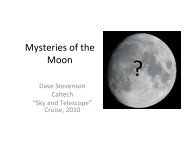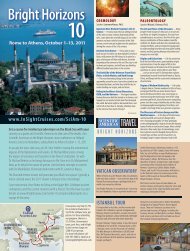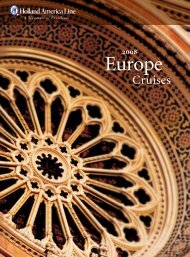Croatian cultural heritage - Business - Hrvatska turistiÄka zajednica
Croatian cultural heritage - Business - Hrvatska turistiÄka zajednica
Croatian cultural heritage - Business - Hrvatska turistiÄka zajednica
Create successful ePaper yourself
Turn your PDF publications into a flip-book with our unique Google optimized e-Paper software.
48 49 50<br />
51<br />
52 53<br />
Franciscan Monastery has a collection of old pharmaceutical<br />
equipment, and the Dominican Convent has a rich<br />
collection of paintings (20) and a nicely decorated garden<br />
(28). Among the religious buildings of other religions is a<br />
synagogue from the 15th century (25), the second oldest in<br />
Europe by virtue of its continued use.<br />
Dubrovnik is well known for its museums, which are annualy<br />
visited by close to half a million visitors. After the<br />
Rector's Palace, the second most visited is the Maritime<br />
Museum, where you can learn about the maritime history<br />
of Dubrovnik from the Middle Ages to the 20th century (12<br />
& 13).<br />
The surrounding area of Dubrovnik doesn’t have many<br />
monumental buildings, but is characterised by the harmony<br />
of architecture embedded in the green environment. This is<br />
especially evident in the southernmost corner of Croatia, in<br />
the fertile valley of KONAVLE.<br />
Konavle comes to the fore with its preservation of beautiful<br />
folk costumes (39) and the preserved building <strong>heritage</strong>,<br />
such as Konavoski Dvori at the source of the river Ljuta (34).<br />
The Konavle ethnographic treasures are kept in the Ethnographic<br />
Museum in Čilipi (37). The southernmost part of<br />
Konavle and the <strong>Croatian</strong> mainland on the Prevlaka Peninsula<br />
is known for its strategic significance; it controls entry<br />
into the Bay of Kotor in the neighbouring Montenegro, and<br />
is still today prevailed by a monumental fortress (33).<br />
The main settlement of Konavle is the picturesque village of<br />
Cavtat (32), birthplace of the great <strong>Croatian</strong> painter Vlaho<br />
Bukovac. His birth house was converted into a gallery (40)<br />
of his paintings (38). Another valuable site in Cavtat is the<br />
Račić family mausoleum from 1921 (35), the work of the<br />
<strong>Croatian</strong> sculptor Ivan Meštrović (36).<br />
The west of Dubrovnik offers the Dubrovnik coastline, famous<br />
for its noble summer residences surrounded by greenery.<br />
On one of these residences, in the picturesque village<br />
of Trsten (42), is the most beautiful <strong>Croatian</strong> arboretum,<br />
where on a small surface are a variety of subtropical species<br />
of plants, flowers and trees. The whole arboretum Trsteno<br />
is arranged as a landscape park decorated with sculptures,<br />
of which the most famous is the statue of the Greek god<br />
Poseidon, in front of the picturesque fountain (45). The arboretum<br />
boasts nicely decorated rest areas from which you<br />
can enjoy the view of the open sea (49).<br />
Further down to the west stretches the naturally most special<br />
part of the Dubrovnik region, THE NERETVA RIVER<br />
DELTA, with preserved wetland landscapes and picturesque<br />
places along the river, among which the town of Opuzen<br />
stands out with its exeptional beauty (46). Near the largest<br />
town of the Neretva river delta, Metković, there is a village<br />
called Vid at the site of the former ancient Narona. Here, at<br />
the original location of the site stands a museum that was<br />
built over a part of the Roman Forum, or Augusteum, with a<br />
number of carved marble imperial statues (43 & 44).<br />
Starting from the coast of Dubrovnik and moving towards<br />
the island of Korčula, we pass through the mountainous<br />
winegrowing peninsula of PELJEŠAC. The old centre of the<br />
peninsula is the scenic town of Ston, located on the isthmus<br />
that connects the peninsula with the mainland. Between<br />
Ston and the neighbouring Mali Ston, famous for the cultivation<br />
of oyster shells, are impressive walls (41).<br />
119
















